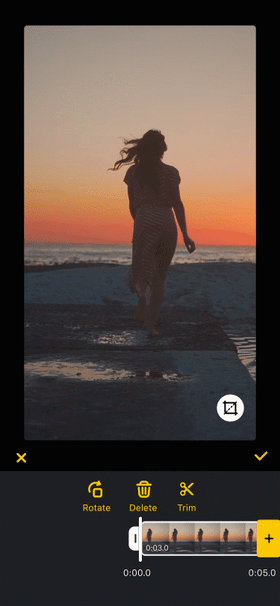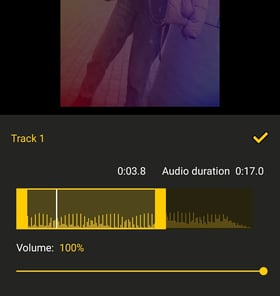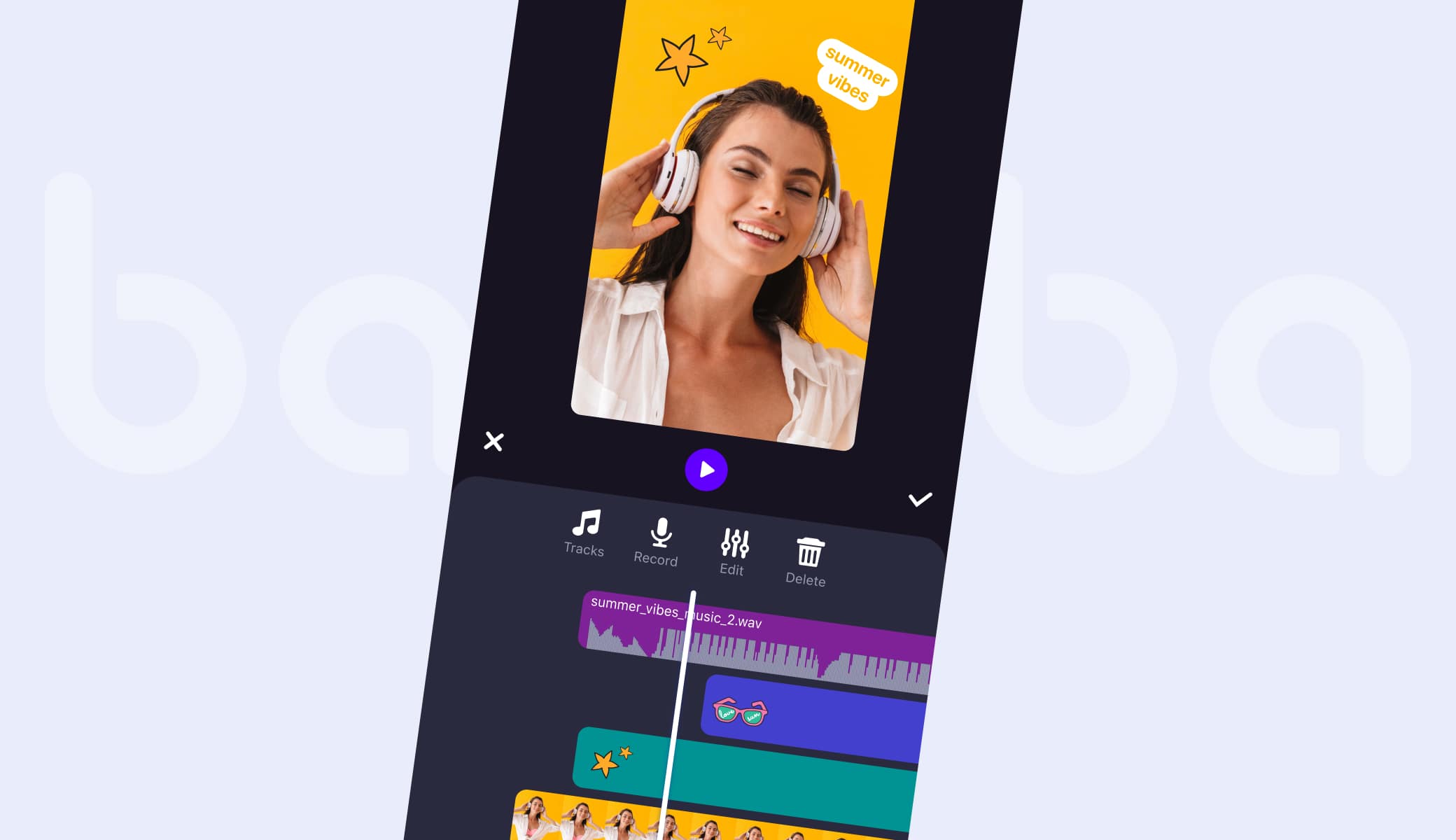Audio Editor for a Video Editor in a Nutshell
The ability to work with sound tracks is a must for any video editing app. However, there could be many differences as to what exactly this means. These are some of the features that can be present:
- Recording. Picking up sound from the inbuilt microphone.
- Cutting tracks. Removing parts of the track.
- Merging tracks. Combining several music tracks into one.
- Sound/voice effects. Various changes to sounds (e.g. making the user sound like a robot or a cartoon character).
- Integration with royalty-free music service. Endless supply of tracks for your users to include in their clips.
However, the ability to add audio to a video editor is just one element of a larger whole. To properly gauge the entire product, take other aspects into account. You can see an example of a detailed comparison in our article: Best Mobile Video Editor SDKs for Short Video Apps: Detailed Comparison.
 Banuba Video Editor SDK. Video trimming
Banuba Video Editor SDK. Video trimming
For most kinds of content, your users will need some sort of music. There are three main ways you can approach the issue. Note that they aren’t mutually exclusive and can be combined.
- Upload files. This is the simplest way. Just let people upload tracks that they have on their phones. From the most barebones apps to the best mobile video editors, this is a required feature.
- License tracks from a publisher. Major companies like Snap worked out deals with record labels to use their tracks, fully or partially. Smaller businesses might have issues with that, however.
- Integration with a royalty-free service. There are companies that build their business around AI-generated music or tracks written specifically to be resold. It can be created on-demand in a number of styles and genres. What’s best is that this music is royalty-free: you only buy a license to use the service that provides it. Examples include Mubert, Soundstripe, Bensound, etc.

3 Core Benefits of Video Audio Editors
Including an audio editor in video apps can provide a number of advantages.
Firstly, it gives your users an “all-in-one” package, where they can work with both visual and audio content without having to go somewhere else. This means they are less likely to uninstall your app and switch to a competitor.
Secondly, including a royalty-free music service protects both you and your users from litigation. Without going into details on copyright laws, this will help videos made with your app to avoid getting claimed on YouTube and other video hosting sites. In addition, you, as a company, will gain a measure of safety from copyright lawsuits as well because you will have all the necessary permissions.
Finally, sound effects can be an additional incentive for viral content creation. They can even be combined with visual ones (e.g. AR masks) for extra fun. For example, imagine giving users a 3D Darth Vader face filter with the accompanying voice effects on May 4th.
How To Add Video Audio/Sound Editor To Your App
As we mentioned above, an audio and sound editor isn’t a standalone application. It usually comes coupled with a full-fledged video modification software. So in this block, we will describe how to integrate a video and audio/sound editor. We are going to use Banuba Video Editor SDK as an example, as this is the product we are most familiar with.
 Banuba Video Editor SDK. Audio editing
Banuba Video Editor SDK. Audio editing
Requirements
The SDK runs on iOS and Android. It can support both native technologies and cross-platform frameworks (Flutter and React Native). These are the general requirements.
Android:
- Java 1.8+
- Kotlin 1.4+
- Android Studio 4+
- Android 6.0 or higher with Camera 2 API.
- OpenGL ES 3.0 (3.1 for Neural networks on GPU).
iOS:
The Android version takes 50 MBs of space, and its iOS counterpart needs 43 MBs. They are delivered as a set of modules represented as .aar for Android and .framework or .xcframework for iOS.
Note that the SDK doesn’t include any audio content. However, there is an easy native integration with Mubert (requires a separate contract with the provider) and instructions on adding any other source. They will be included in the specific sections, dedicated to each platform.
Starting a trial
The best way to get started is to request a free 14-day trial. It will let you test the video and audio editor and make up your mind.
Doing this is simple: just send us a message through a contact form.

iOS integration
The specific steps, along with the code samples, can be found on our GitHub page. It also includes the list of dependencies, technical nuances, customization options, etc. There is also FAQ, that will answer any questions you may have. To integrate a music provider, follow this guide.
Android integration
The guide for integration with Android can be found on the relevant GitHub page. As with iOS, there are also dependencies, supported media formats, recording quality parameters, and customization options. And this is the FAQ for Android. And this is how you integrate a music provider.
Flutter, React Native integration
You can also integrate Banuba Video Editor SDK with an app built with Flutter and React Native. Click the framework you are interested in to see the guide.
Wrapping up
An audio editor for a video editor is an important part of the overall offering. With the ability to use sound tracks from the person’s phone or an external service, it provides significant value in terms of creativity and emotional impact that the videos can make. With this article, you will have everything you need to get started with one. So don’t hesitate, take the first step, and contact us!




 Banuba Video Editor SDK. Video trimming
Banuba Video Editor SDK. Video trimming
 Banuba Video Editor SDK. Audio editing
Banuba Video Editor SDK. Audio editing

